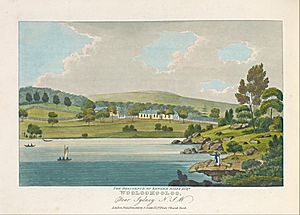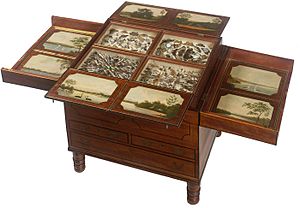Joseph Lycett facts for kids
Quick facts for kids
Joseph Lycett
|
|
|---|---|
| Born | 1774 Staffordshire, England
|
| Died | 1828 Birmingham, England
|
| Occupation | Convict portrait and miniature painter |
| Children | Possibly 2 daughters |

Joseph Lycett (born around 1774 – died 1828) was a talented artist who painted portraits and small pictures called miniatures. He was active in Australia during its early colonial days. Lycett was sent to Australia as a convict because he had been involved in making fake banknotes. In Australia, he became known for his detailed paintings of towns and beautiful landscapes.
Contents
Early Life and Art Skills
Joseph Lycett was born in Staffordshire, England. From a young age, he developed skills as a botanical artist, meaning he drew plants. By 1810, people knew him as an engraver (someone who carves designs into metal or wood) and a drawer. He was also good at painting portraits and miniatures. Lycett had a partner named Mary Stokes, who was also known as Mary Lycett.
Life as a Convict Artist
Time in Newcastle
Lycett was found guilty of forgery on August 10, 1811, after being caught by the Bank of England. He was then transported to Australia, arriving in Sydney on February 7, 1814. His first job in Australia was working as an artist.
However, Lycett got into trouble again for making fake money. He was sent to Newcastle on the ship Lady Nelson. In Newcastle, he caught the attention of Captain James Wallis, who was in charge of the settlement. Lycett helped Captain Wallis by drawing plans for a church. When the church was built in 1818, Lycett painted the altar piece. He is also believed to have created a special three-light window that is still in the bishop's vestry of Newcastle Cathedral today.
Because of his artistic contributions, Captain James Wallis recommended Lycett for a conditional pardon, which meant he had more freedom. While in Newcastle, Lycett also painted Corroboree at Newcastle. This is the first known oil painting to show an Aboriginal corroboree (a traditional gathering and dance) at night. Lycett painted at least 14 scenes showing the cultural practices of the Awabakal people.
Special Collectors' Chests

Captain James Wallis also asked Lycett to help design two special wooden chests made from cedar and rosewood. These chests were meant to display natural history items from the Newcastle area. Lycett was responsible for painting eight of the twelve panels on these chests. His paintings showed views of Newcastle and copies of other famous Australian artworks.
It is believed that Captain Wallis gave one of these beautiful chests to Governor Lachlan Macquarie as a gift around 1818. The other chest was later bought by William Dixson in London and then given to the State Library of New South Wales, where Governor Macquarie's chest is also kept.
Return to Sydney
After his time in Newcastle, Lycett was allowed to return to Sydney and continue his art. In 1820, Governor Macquarie sent three of Lycett's paintings, including a large view of Sydney, to Earl Bathurst in England. Many people believe that Lycett received a full pardon on November 28, 1821, as a reward for these artworks. Many important people, including military officers and government officials, supported his art.
Lycett planned to leave Australia with his two daughters, Mary Ann and Emma. They sailed together on the ship Shipley on September 8, 1822.
Views in Australia Book
Joseph Lycett returned to England in September 1822 after receiving his full pardon. Even though his later book, Views in Australia, shows scenes from Tasmania, there is no proof that he actually traveled there.
Between July 1824 and June 1825, Lycett worked with publisher John Souter to release Views in Australia, or New South Wales and Van Diemens Land. This book came out in 13 monthly parts. Each part included two aquatint views of New South Wales and two of Van Diemen's Land (which is now Tasmania), along with descriptions. There was also a supplement with maps of both colonies. The series was dedicated to Earl Bathurst. The book was later reissued as a single volume in 1825. Some copies of the book have colored plates, while others are plain.
Later Life and Death
By 1827, Lycett faced legal troubles again. He became ill during this time. Joseph Lycett passed away in Birmingham Hospital on February 9, 1828. He was buried in St Mary's Churchyard in Birmingham.
See also
- List of convicts transported to Australia
Images for kids



